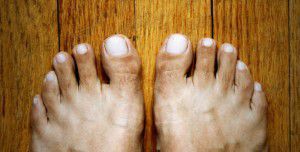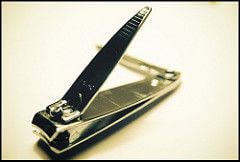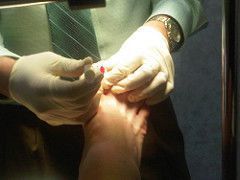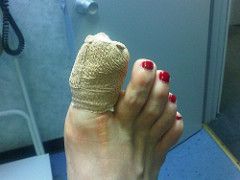Fungi thrive in warm, moist, dark places such as close-toed shoes. This is one of the most common causes of toenail fungus, however it is not the only. Fungal infection is the most common cause of yellow toenails; however rarely some other disease conditions can also cause yellow toenails. Some of these conditions are psoriasis, jaundice, paronychia, lymphedema, bronchiectasis and tuberculosis. However, with these other conditions, usually there will be other symptoms also typically including the discoloration of the fingernails.
If a fungus is the cause of your discolored or thick toenails you may notice have streaks of discoloration and the nail may appear more brittle. If you’re unable to scrape off the yellow color with a nail file, chances are you’ll dealing with a fungus. Some toenail polishes can turn nails yellow.
If your feet are exposed to warm and moist public places such as locker rooms you are at higher risk for fungal nail infection. Fungi thrive in these warm, moist environments and even your footwear can cause this environment that fungi love. Your risk also increases when your feet are kept in damp sweaty socks or not properly drying your feet. Wearing tight fitting shoes can also cause your feet to sweat. This can create the environment for fungi to grow and create thick yellow fungal toenails.
How to Treat Fungal Toenails
Because people are often inclined to hide their yellow or “ugly toenails” they keep them confined. This can make the problem worse by sealing in the fungus. If the fungal infection is allowed to continue untreated, you may end up losing the entire toenail. Additionally, the infection can spread to other people if you share towels or footwear. The best solution is to see your doctor for treatment. There are oral medicines and topical medicines that have traditionally been used to treat this condition.
Over the counter topical medicines may be effective in some cases, however require long-term consistent use and many people do not have success with this treatment. With other more advanced cases some doctors may prescribe an oral medication. Many people cannot, or do not want to attempt the use of, the oral anti-fungal because it can cause elevated liver enzymes. Sometimes combined systemic and topical anti-fungal medications may also be prescribed. Usually prolonged treatment for up to 1 year may be required to cure a fungal toenail infection. As a result, many people are choosing the latest laser technology as their treatment for this condition.
Have your fungal toenail(s) evaluated by the doctors who specialize in effectively treating this condition today. They will evaluate your condition and design a treatment plan specifically tailored to your case. Read our section about Treatment Options for more details.
Prevention of Fungal Toenails
The fungi causing yellow toenails require warm, moist and dark environment to grow. Wearing closed shoes for prolonged duration provide this ideal environment for the fungi to grow. Moreover, inadequate personal hygiene also makes one more susceptible to develop toenail fungal infection. Poor blood circulation in the feet and increased sweating also predisposes to toenail fungal infection.
Therefore, preventing measures involve regular washing of the feet with soap and water and allowing them to become completely dry. Wearing shoes for prolonged duration should be avoided as much as possible. Feet should be completely dried before wearing closed footwear. Moisture absorbing socks are better to keep feet relatively dry, especially if one sweats more than usual. Toenails should be adequately trimmed. Regular exercising (walking, running, etc.) helps to improve blood circulation in feet and reduces chances of toenail fungal infection.
- Wear Clean Dry Socks
- Wear Breathable Footwear
- Avoid Going Barefoot in Public and Damp Areas
- Avoid Sharing Towels, Bathmats and Clothes if Someone Else has a Fungal Infection.
- Clean and Dry Your Feet and Toes Daily.
- Maintain Proper Foot and Toenail Hygiene.






 Choose appropriate footwear – If you are active and participate in sports select footwear designed for that specific type of activity. A toe box appropriate for your foot structure is important preventing ingrown toenails and other injuries. Shoes that you wear every day should have plenty of room around your toes. Shoes that you wear for walking briskly or for running should have plenty of room also, but not be too loose.
Choose appropriate footwear – If you are active and participate in sports select footwear designed for that specific type of activity. A toe box appropriate for your foot structure is important preventing ingrown toenails and other injuries. Shoes that you wear every day should have plenty of room around your toes. Shoes that you wear for walking briskly or for running should have plenty of room also, but not be too loose. Perfect your cuts – When trimming nails be conscious of how short and curved you trim your nails. The more skin exposed the greater the opportunity the nail has to regrow into the skin. Always use a clean, sharp nail trimmer. When trimming your toenails consider briefly soaking your foot in warm water to soften the nail. Trim toenails straight across the top, do not taper or round the corners or trim too short. Never pick at or tear your nails.
Perfect your cuts – When trimming nails be conscious of how short and curved you trim your nails. The more skin exposed the greater the opportunity the nail has to regrow into the skin. Always use a clean, sharp nail trimmer. When trimming your toenails consider briefly soaking your foot in warm water to soften the nail. Trim toenails straight across the top, do not taper or round the corners or trim too short. Never pick at or tear your nails.


